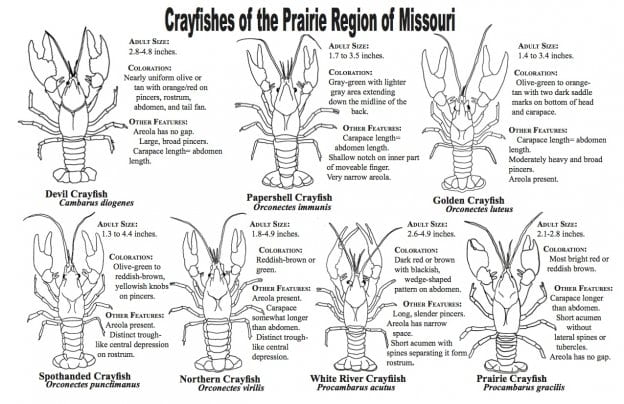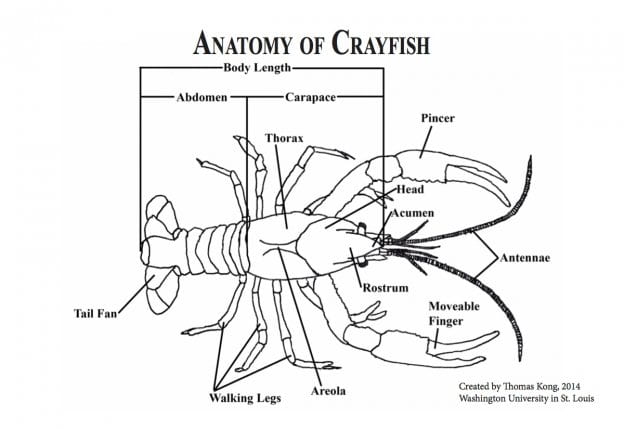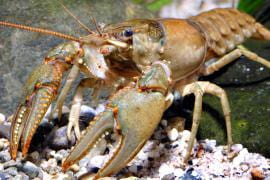A field guide to identifying crayfish in the Prairie Region of Missouri


Background Information
Crayfish are part of the Phylum of invertebrates called Arthropods, including animals such as insects, spiders, and sowbugs. Crayfish are further classified as part of the Class Crustacea, which is characterized by the ability to breathe with gills and having two pairs of antennae. Crayfish are further classified in the Order Decapoda, which in Latin means “ten-footed”.
Missouri has a very diverse number of crayfish, which can be broken up into four broad categories: stream dwellers; swamp, marsh, and pond dwellers; cave dwellers; and burrowers. Stream dwellers live in surface waters that have a noticeable current or flow for the majority of the year. Swamp, marsh, and pond dwellers live in surface waters that lack significant current or flow. Cave dwellers live in underground streams and lakes. Burrowers live the majority of their time in tunnels that they dig in the ground and at times are quite a distance from surface waters.
The crayfish of Missouri have four principal aquatic faunal regions: Ozark, Lowland, Prairie, and Big River. These four regions help to identify typical crayfish habitat and centers of distribution. This guide will be focusing on the crayfish species that can be found in the prairie faunal region.
The Importance of Crayfish
In the United States, crayfish are one of the most dominant groups of macro-invertabrates. Crayfish are an important food source to many species such as fish, racoons, snapping turtles, herons, and particularly the hellbender salamander, which is an endangered species in Missouri. Crayfish also serve as a huge source of food and fish bait for humans. Over 53,000 metric tons of crayfish are harvested in the United States for food every year. However, burrowing crayfish are considered a pest to agriculture in certain parts.
Prairie Faunal Region
The prairie region includes most of Missouri that is north of the Missouri River along with an area south of the river between the Ozarks and the Kansas state line. The topography of this region is mostly made up of flat to rolling plains with belts of low hills along the major streams. Shale and thin sandstones make up most of the bedrocks beneath this region. Many of the streams in this region have been channelized and are made up of sand and silt as substrates; however, gravel, rock, and outcrops of bedrock can be found in some areas.
Crayfish Species
Burrowers:
Prairie Crayfish:

Source: Chris Lukhaup http://mdc.mo.gov/media/image/prairie-crayfish?popup
This primarily burrowig crayfish lives in grasslands or areas where native grasses were once found. They dig burrows up to six or more feet deep. This species is found throughout the prairie faunal region, but is barely found inside the Ozarks along its southwestern boundary. Compared to the devil crayfish, the prairie crayfish has a distinctly shorter carapace length in comparison to its abdominal length.
Devil Crayfish:

Source: Chris Lukhaup http://http://mdc.mo.gov/media/image/devil-crayfish?popup
The devil crayfish is found nearly statewide however it is absent from the southwestern Ozark (White and Neosho drainages). Their burrows are mostly found along the banks of streams, but also in low, swampy areas. Compared to the grassland crayfish, the carapace length is nearly equal to the abdominal length.
Stream Dwellers:
Northern Crayfish:

Source: Chris Lukhaup http://mdc.mo.gov/media/image/virile-crayfish?popup
The norther crayfish is also known as the virile crayfish. It is the most widely distributed species in Missouri, found all over the state except for the southeastern Lowlands and parts of the central Ozarks. It is the most abundant species of the Prairie region. This species is most abundant in streams that are fertile, warm, and moderately turbid, but without strong base flows. They enjoy cover in slab rock, logs, and organic debris. In comparison to the spothanded crayfish, the northern crayfish lacks the black spot at the base of its moveable finger.
Golden Crayfish:

Source: Missouri Department of Conservation staff http://mdc.mo.gov/media/image/golden-crayfish?popup
The golden crayfish is one of the mose common species in the Ozarks, except for the Black Eleven Point, White and Neosho stream drainages. This species lives in streams ranging in size from headwater creeks to large rivers, particularly ones with rocky and gravelly substrates and relatively permanent flow. Look for the golden crayfish on rocky riffles or along the shores of rocky pools. This species is active, agile, and a strong swimmer.
Spothanded Crayfish:

Source: Missouri Department of Conservation staff http://mdc.mo.gov/media/image/spothanded-crayfish?popup
The spothanded crayfish’s range includes most of the eastern half of the Ozark region, including parts of Callaway, Montgomery, and Warren counties north of the Missouri River. This species is nocturnal, alert, active, and a strong swimmer.
Swamp, Slough, and Pond Dwellers:
White River Crayfish:

Source: Chris Lukhaup http://mdc.mo.gov/media/image/white-river-crayfish?popup
This species can be found throughout the lowland faunal region. Isolated populations were found next to the Chariton River and Grand River. They can be found in sloughs, marshes and natural lakes next to flood plains of streams.
Papershell Crayfish:

Source: Chris Lukhaup http://mdc.mo.gov/media/image/calico-crayfish?popup
The papershell crayfish is also known as the calico crayfish. The papershell crayfish can be found in the prairie faunal region and on the flood plains of the Missouri and upper Mississippi River. This species is most often found where predatory fish and other species of fish are scarce or absent. Adults are nocturnal, while juveniles are active throughout the day. This species is a prolific breeder and is an important prey in the diet of bass, bullhead catfish, and trout.
Sources
Many thanks to William L. Pflieger for his book The Crayfishes of Missouri from which much I learned most of the information shared above.
Here is a printable version.
/files/pages/imce/mnh/cray_fish_identification_card_final_project_1.pdf